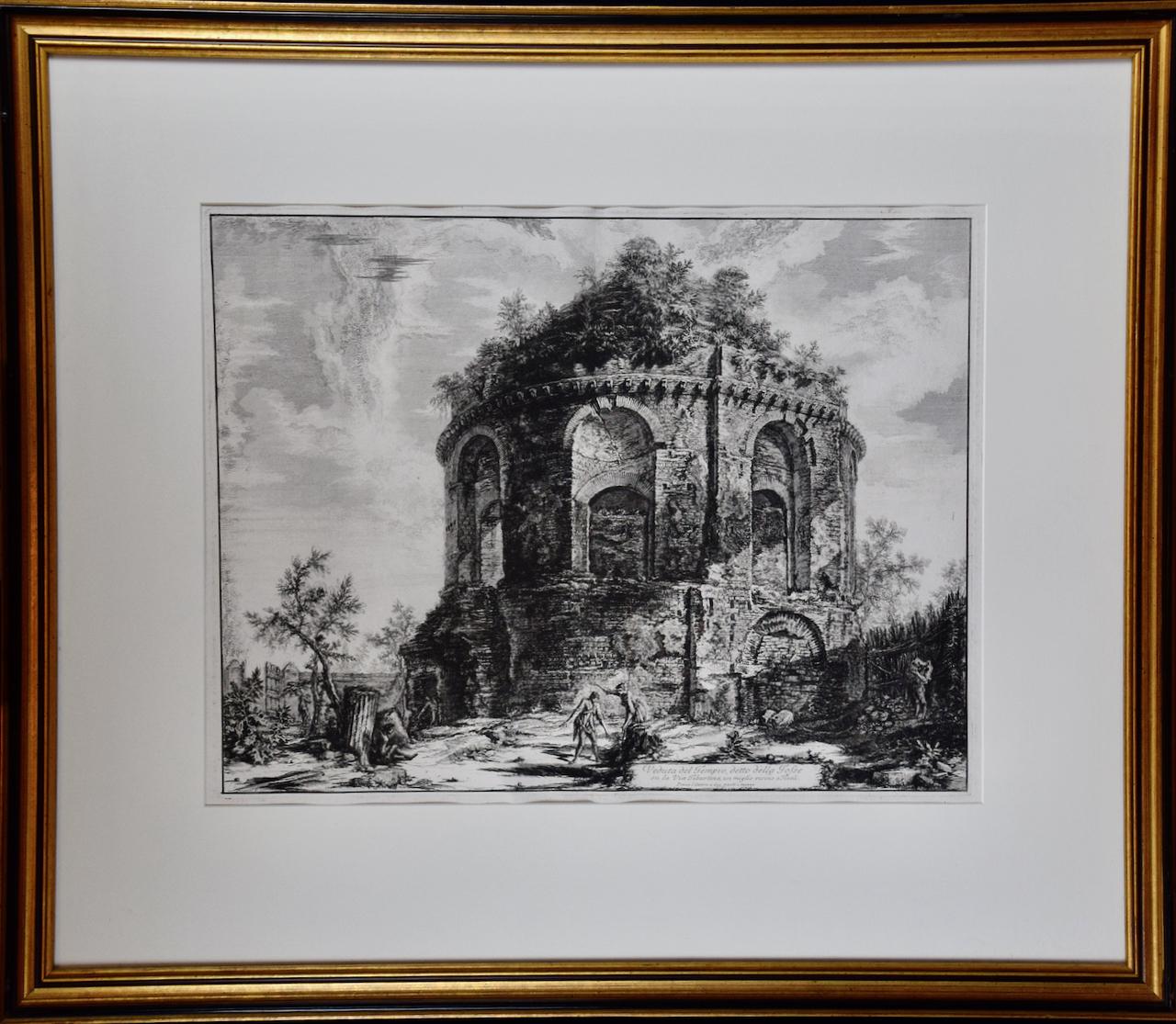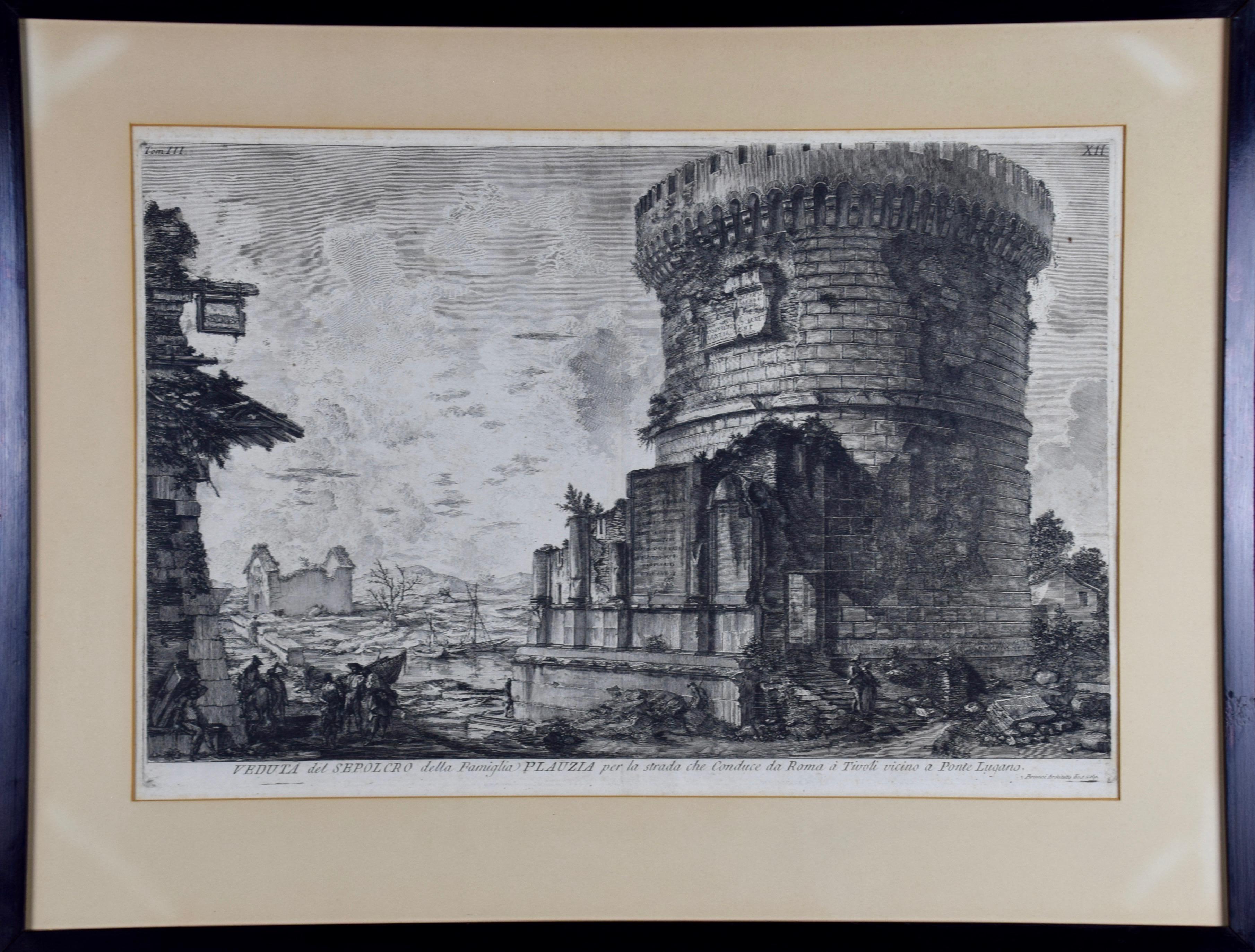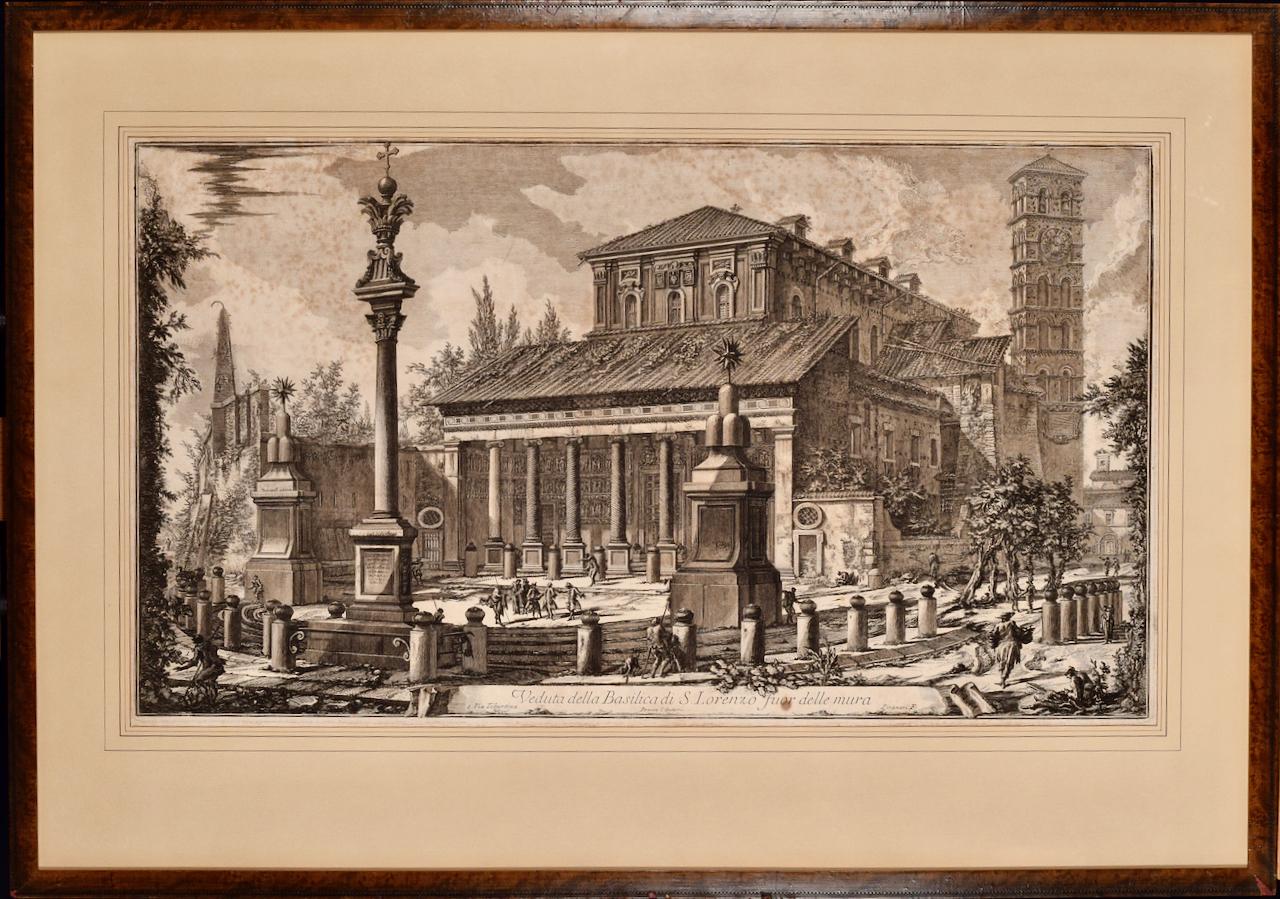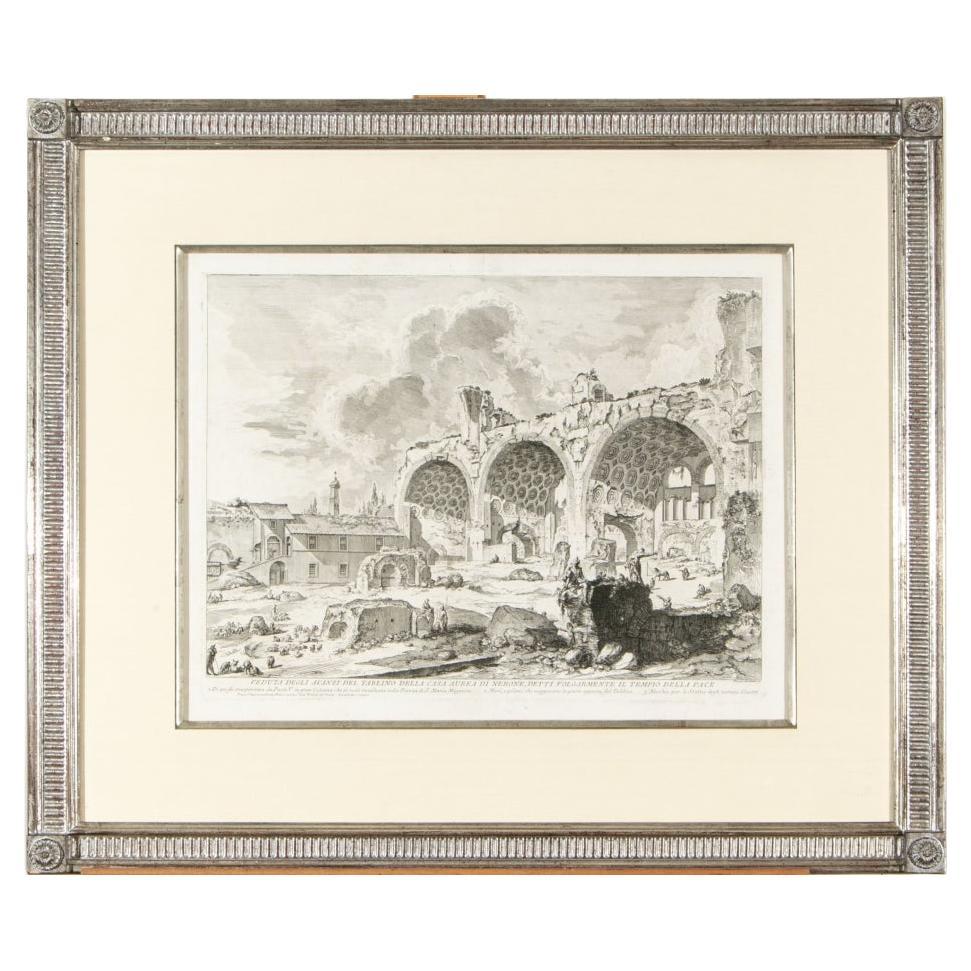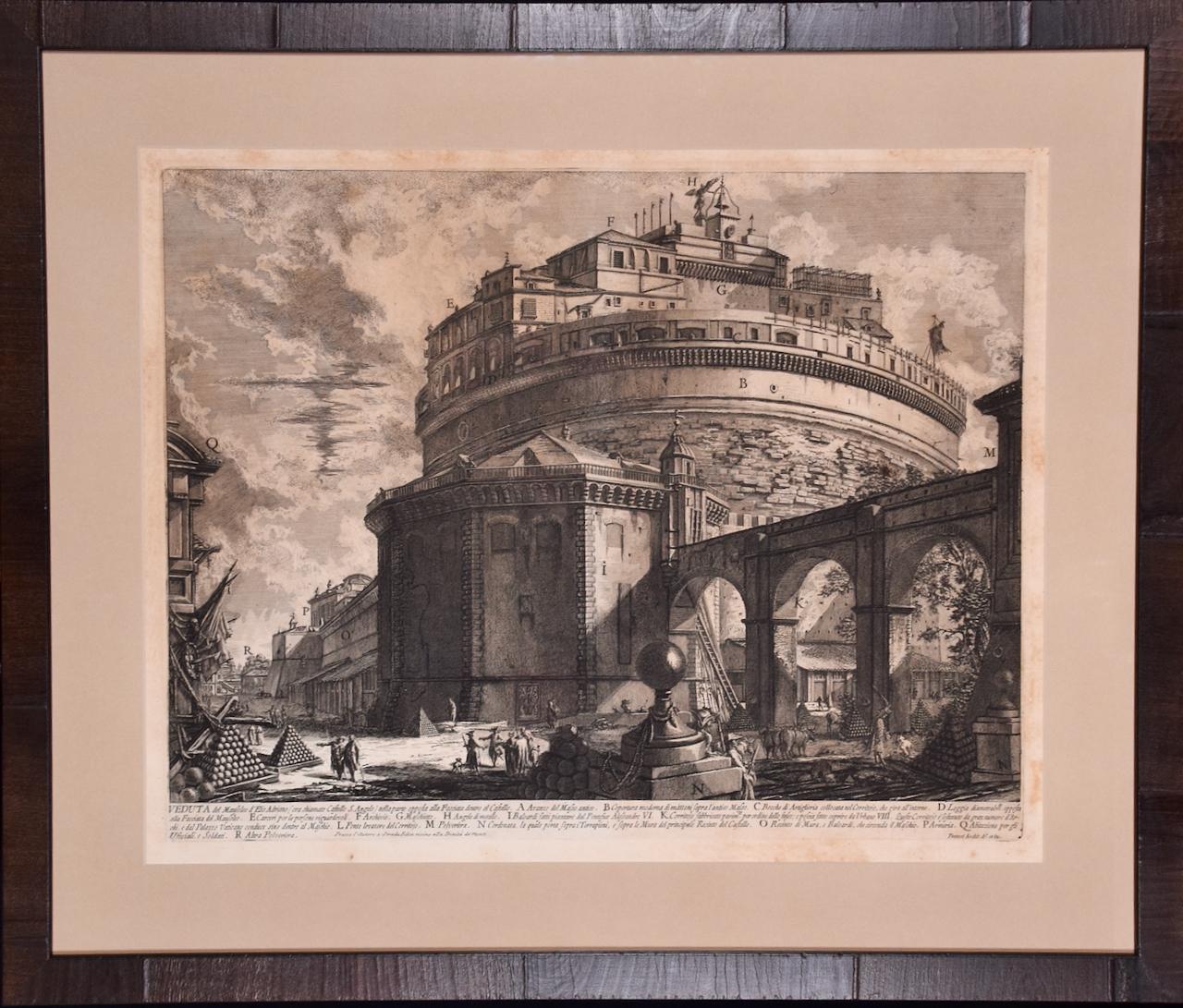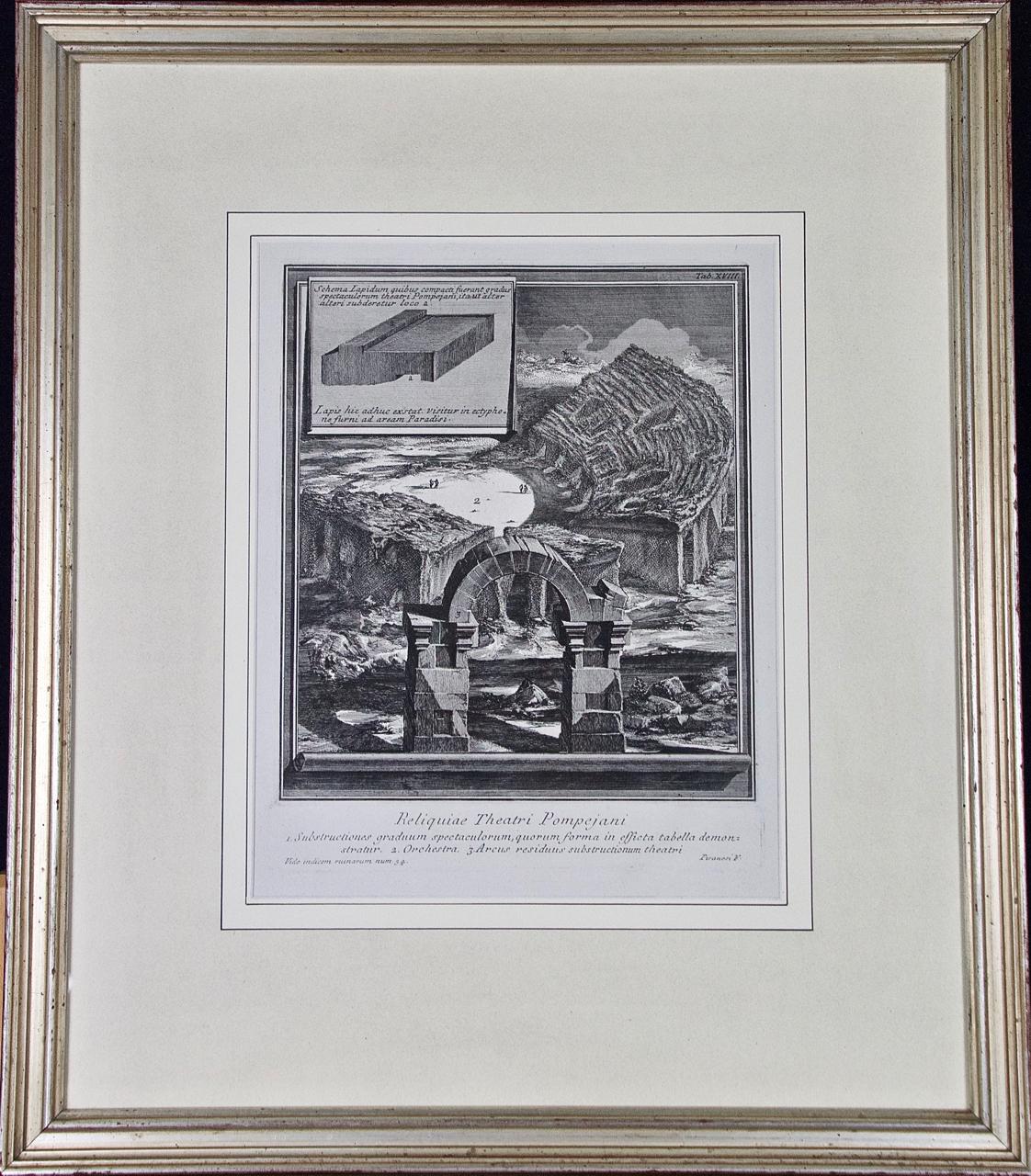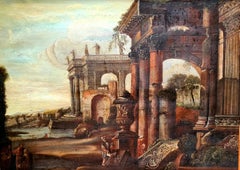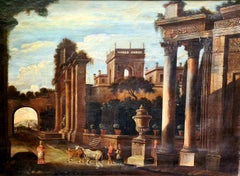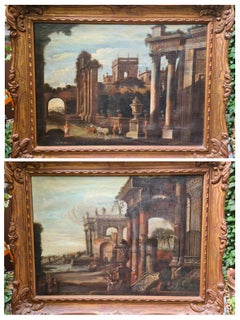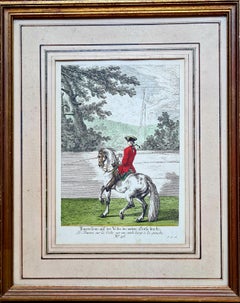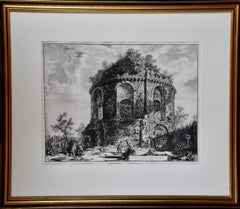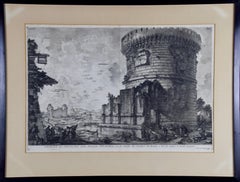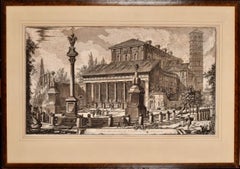Items Similar to Piranesi, Hand Coloured Period Engraving, Vue d'un Superb Palais de Rome
Want more images or videos?
Request additional images or videos from the seller
1 of 12
Piranesi, Hand Coloured Period Engraving, Vue d'un Superb Palais de RomePublished Circa 1770
Published Circa 1770
$1,316.37
£977.85
€1,100
CA$1,816.03
A$1,996.32
CHF 1,049.17
MX$24,242.54
NOK 13,088.15
SEK 12,400.10
DKK 8,373.77
About the Item
A fine hand coloured 18th Century engraving after the original by Piranesi (Rome 1743), published by Danisy, Paris. Presented in period gold leaf frame, under glass.
Piranesi was born in Venice, in the parish of S. Moisè where he was baptised. His father was a stonemason. His brother Andrea introduced him to Latin literature and ancient Greco-Roman civilization, and later he was apprenticed under his uncle, Matteo Lucchesi, who was a leading architect in Magistrato delle Acque, the state organization responsible for engineering and restoring historical buildings.
From 1740, he had an opportunity to work in Rome as a draughtsman for Marco Foscarini, the Venetian ambassador of the new Pope Benedict XIV. He resided in the Palazzo Venezia and studied under Giuseppe Vasi, who introduced him to the art of etching and engraving of the city and its monuments. Giuseppe Vasi found Piranesi's talent was much greater than that of a mere engraver. According to Legrand, Vasi told Piranesi that "you are too much of a painter, my friend, to be an engraver."
After his studies with Vasi, he collaborated with pupils of the French Academy in Rome to produce a series of vedute (views) of the city; his first work was Prima parte di Architettura e Prospettive (1743), followed in 1745 by Varie Vedute di Roma Antica e Moderna.
From 1743 to 1747, he was mainly in Venice where, according to some sources, he often visited Giovanni Battista Tiepolo, a leading artist in Venice. It was Tiepolo who expanded the restrictive conventions of reproductive, topographical and antiquarian engravings. He then returned to Rome, where he opened a workshop in Via del Corso. In 1748–1774, he created an important series of vedute of the city which established his fame. In the meantime Piranesi devoted himself to the measurement of many of the ancient buildings: this led to the publication of Le Antichità Romane de' tempo della prima Repubblica e dei primi imperatori ("Roman Antiquities of the Time of the First Republic and the First Emperors"). In 1761, he became a member of the Accademia di San Luca and opened a printing house of his own. In 1762, the Campo Marzio dell'antica Roma collection of engravings was printed.
The following year he was commissioned by Pope Clement XIII to restore the choir of San Giovanni in Laterano, but the work did not materialize. In 1764, one of the Pope's nephews, Cardinal Rezzonico, appointed him to start his only architectural work, the restoration of the church of Santa Maria del Priorato in the Villa of the Knights of Malta, on Rome's Aventine Hill. He combined Classical architectural elements, trophies and escutcheons with his own particular imaginative genius for the design of the facade of the church and the walls of the adjacent Piazza dei Cavalieri di Malta.
In 1767, he was made a knight of the Golden Spur, which enabled him to sign himself "Cav[aliere] Piranesi". In 1769, his publication of a series of ingenious and sometimes bizarre designs for chimneypieces, as well as an original range of furniture pieces, established his place as a versatile and resourceful designer.[1] In 1776, he created his best known work as a 'restorer' of ancient sculpture, the Piranesi Vase, and in 1777–78 he published Avanzi degli Edifici di Pesto (Remains of the Edifices of Paestum).
He died in Rome in 1778 after a long illness, and was buried in the church he had helped restore, Santa Maria del Priorato. His tomb was designed by Giuseppi Angelini.
Even though the social structure by an aristocracy remained rigid and oppressive, Venice revived through the Grand Tour as the center of intellectual and international exchange in the eighteenth century. The ideas of the Enlightenment stimulated theorists and artists all over Europe including Paris, Dresden, and London. New forms of artistic expression emerged: veduta, capriccio, and veduta ideata, topographical view, architectural fantasy, accurate renderings of ancient monuments assembled with imaginary compositions in response to the demand of increased visitors.
The developing center of the Grand Tour was Rome. Rome became a new meeting place and intellectual capital of Europe for the leaders of a new movement in the arts. The city was attracting artists and architects from all over Europe beside the Grand Tourists, dealers and antiquarians. While many came through official institutions such as the French Academy, others came to see the new discoveries at Herculaneum and Pompeii. Coffee shops were frequent gathering places, most famously the Antico Caffè Greco, established 1760. The Caffe degli Inglesi opened several years later, at the foot of the Spanish Steps in Piazza di Spagna, with wall paintings by Piranesi. With his own print workshop and museo of antiquities nearby, Piranesi was able to cultivate relationships in both places with wealthy buyers on the tour, particularly English.
The remains of Rome kindled Piranesi's enthusiasm. Informed by his experience in Venice and his study of the works of Marco Ricci and particularly Giovanni Paolo Panini, he appreciated not only the engineering of the ancient buildings but also the poetic aspects of the ruins. He was able to faithfully imitate the actual remains; his invention in catching the design of the original architect provided the missing parts. His masterful skill at engraving introduced groups of vases, altars, tombs that were absent in reality; his manipulations of scale; and his broad and scientific distribution of light and shade completed the picture, creating a striking effect from the whole view.
A number of the Views are notable for depicting human figures whose poverty, lameness, apparent drunkenness, and other visible flaws appear to echo the decay of the ruins. This is consistent with a familiar trope of Renaissance literature, in which the ruins of Rome are lamented as a metaphor for the imperfection and transience of human existence.
Some of his later work was completed by his children and several pupils. Piranesi's son and coadjutor, Francesco, collected and preserved his plates, in which the freer lines of the etching-needle largely supplemented the severity of burin work. Twenty-nine folio volumes containing about 2000 prints appeared in Paris (1835–1837).
The late Baroque works of Claude Lorrain, Salvatore Rosa, and others had featured romantic and fantastic depictions of ruins; in part as a memento mori or as a reminiscence of a golden age of construction. Piranesi also made copies of a number of etchings by Israel Silvestre, whose works he apparently admired. Piranesi's reproductions of real and recreated Roman ruins were a strong influence on Neoclassicism.
One of the main features of Neo-Classicism is the attitude towards nature and the uses of the past. Neo-Classicism was prompted by the discoveries at Herculaneum and Pompeii. Rediscovery and revaluation of Greece, Egypt, and Gothic was also active as well as the various expeditions of unfamiliar Roman empire. The view of a Golden Age was changing from static to mutable, inspired by Rousseau and Winckelmann in response to the dynamic growth of society.
The wider perspective on the past created a new way of expression. Artists developed a greater self-consciousness in confronting the limited authority of the ancient world, and there was a growing interest in civilizations and the destiny of nations. Piranesi was especially interested in the Graeco-Roman debate in the 1760s, between followers of Winckelmann who thought Greek culture and architecture superior to their Roman counterparts, and those who (like Piranesi) believed that the Romans had improved upon their Greek models. His free relationship to the past may be summarized in a phrase of his that become a mantra: "col sporcar si trova"; "by messing about, one discovers".
Throughout his lifetime, Piranesi created numerous prints depicting the Eternal City; these were widely collected by gentlemen on the Grand Tour. The Lobkowicz Collections, housed at the Lobkowicz Palace in Prague, contains a group of twenty-six of his engravings.
- Creation Year:Published Circa 1770
- Dimensions:Height: 14 in (35.56 cm)Width: 18.25 in (46.36 cm)Depth: 0.5 in (1.27 cm)
- Medium:
- Movement & Style:
- After:Giovanni Battista Piranesi (1720-1778, Italian)
- Period:
- Condition:Some wear to the frame.
- Gallery Location:Cotignac, FR
- Reference Number:Seller: LG/Piranesi1stDibs: LU1430210696222
About the Seller
5.0
Platinum Seller
Premium sellers with a 4.7+ rating and 24-hour response times
Established in 2000
1stDibs seller since 2020
263 sales on 1stDibs
Typical response time: 2 hours
- ShippingRetrieving quote...Shipping from: Cotignac, France
- Return Policy
Authenticity Guarantee
In the unlikely event there’s an issue with an item’s authenticity, contact us within 1 year for a full refund. DetailsMoney-Back Guarantee
If your item is not as described, is damaged in transit, or does not arrive, contact us within 7 days for a full refund. Details24-Hour Cancellation
You have a 24-hour grace period in which to reconsider your purchase, with no questions asked.Vetted Professional Sellers
Our world-class sellers must adhere to strict standards for service and quality, maintaining the integrity of our listings.Price-Match Guarantee
If you find that a seller listed the same item for a lower price elsewhere, we’ll match it.Trusted Global Delivery
Our best-in-class carrier network provides specialized shipping options worldwide, including custom delivery.More From This Seller
View AllLarge Grand Tour 18th Century Capriccio Painting Roman Ruins after Gennaro Greco
Located in Cotignac, FR
A fine, large 18th century veduta capriccio scene with temple ruins after Gennaro Greco from the circle of Pietro Cappelli. The painting is presented in a more modern carved gilt woo...
Category
18th Century Baroque Landscape Paintings
Materials
Oil, Canvas
$9,094 Sale Price
20% Off
Grand Tour 18th Century Veduta Capriccio Painting, After Gennaro Greco
Located in Cotignac, FR
A fine, large 18th century veduta capriccio scene with temple ruins after Gennaro Greco from the circle of Pietro Cappelli. The painting is presented in a more modern carved gilt woo...
Category
18th Century Baroque Landscape Paintings
Materials
Oil, Canvas
$9,094 Sale Price
20% Off
Pair of Grand Tour 18th Century Veduta Capriccio Paintings, After Gennaro Greco
Located in Cotignac, FR
A large pair of 18th century veduta capriccio scenes with temple ruins after Gennaro Greco from the circle of Pietro Cappelli. The paintings are presented in more modern carved gilt ...
Category
18th Century Baroque Landscape Paintings
Materials
Canvas, Oil
$15,078 Sale Price
30% Off
Hand Coloured 18th Century Copper engraving from "Small Riding School" No 26
Located in Cotignac, FR
Mid 18th century hand coloured copper plate engraving of an equestrian subject by Johann Elias Ridinger. Initial signed 'in the plate' bottom right. Presented in a fine gilt wood fra...
Category
Mid-18th Century Rococo Animal Prints
Materials
Watercolor, Ink
Hand Coloured 18th Century Copper engraving from "Small Riding School" No 32
Located in Cotignac, FR
Mid 18th century hand coloured copper plate engraving of an equestrian subject by Johann Elias Ridinger. Initial signed 'in the plate' bottom right. Presented in a fine gilt wood fra...
Category
Mid-18th Century Rococo Animal Prints
Materials
Watercolor, Ink
19th Century Pastel & Pencil on Paper. The Royal Palace, Monte Carlo, Monaco.
By Hercules Brabazon Brabazon
Located in Cotignac, FR
Mid 19th century pastel drawing view of the Royal Palace, Monte Carlo, Monaco by British artist Hercules Brabazon Brabazon. The work is titl...
Category
Mid-19th Century Landscape Drawings and Watercolors
Materials
Paper, Pastel, Pencil
You May Also Like
Ancient Roman Temple Architecture: An 18th Century Framed Etching by Piranesi
By Giovanni Battista Piranesi
Located in Alamo, CA
This is an 18th century etching by Giovanni Battista Piranesi entitled "Veduta del Tempio detto della Tosse su la Via Tiburtina, un miglio vicino a Tivoli" (View of the so-called Tem...
Category
1760s Old Masters Figurative Prints
Materials
Etching
Ancient Roman Architecture: Original Framed 18th C. Etching by G. Piranesi
By Giovanni Battista Piranesi
Located in Alamo, CA
"Veduta del Sepolcro della Famiglia Plauzia per la Strada Che Conduce da Roma a Tivoli vicino a Ponte Lugano" from "Le Antichità Romane" (Roman Antiquities), one of the most famous works by Piranesi. "Antichita" illustrates the tombs along the Appian Way...
Category
Early 18th Century Old Masters Figurative Prints
Materials
Etching, Engraving, Drypoint
Basilica of San Lorenzo in Rome: A Framed 18th Century Etching by Piranesi
By Giovanni Battista Piranesi
Located in Alamo, CA
This large framed 18th century etching by Giovanni Battista Piranesi entitled "Veduta della Basilica di S. Lorenzo fuor della mura" (Basilica of San Lorenzo Outside the Walls), published in Rome in 1750 in Piranesi's Vedute di Roma (Views of Rome), This etching depicts the Basilica of San Lorenzo Outside the Walls, which is a Roman Catholic papal basilica and parish church, located in Rome, Italy. The Basilica is one of the Seven Pilgrim Churches of Rome and one of the five "papal basilicas". It was built as a shrine to the martyred Roman deacon St. Lawrence.
This Piranesi etching is held by many museums and institutions, including: The Metropolitan Museum, The British Museum, The National Gallery of Art, The Yale University Art Gallery, and The Harvard Museum of Art.
This magnificent etching is presented in a brown-colored wood frame and a tan French...
Category
1750s Old Masters Landscape Prints
Materials
Etching
Giovanni Battista Piranesi, 18th C. Engraving, View Of The Ruins
By Giovanni Battista Piranesi
Located in Bridgeport, CT
Italian, 1720-1778. With an expected fold down the middle. View of the "Casa Aurea Nerone". From the "Veduta di Roma" series. Artist name in plate lower right.
Dimensions: sight 17...
Category
Antique 18th Century Italian Renaissance Prints
Materials
Glass, Wood, Paper
Hadrian's Mausoleum, Castel S. Angelo: A Framed 18th Century Etching by Piranesi
By Giovanni Battista Piranesi
Located in Alamo, CA
This large framed 18th century etching by Giovanni Battista Piranesi entitled "Veduta del Mausoleo d'Elio Adriana ora chiamato Castello S. Angelo nella parte opposta alla Facciata de...
Category
1750s Old Masters Landscape Prints
Materials
Etching
Piranesi 18th C. Etching "Reliquiae Theartri Pompejani" an Ancient Roman Theater
By Giovanni Battista Piranesi
Located in Alamo, CA
This a framed Giovanni Battista Piranesi (1720-1778) etching entitled "Reliquiae Theartri Pompejani" (Remains of the Theatre of Pompey) from "Il Campo Marzio dell'Antica Roma" (The Campus Martius of Ancient Rome), published in Rome in 1762. It depicts the remains of an ancient theater in Rome with exposed seating and an arch still standing in the foreground. An inset shows an architectural side view of a portion of the structure.
The etching is presented in an antiqued silver-colored wood frame with a cream-colored French mat. The frame measures 24" x 20.75" x 1.25". The print is in excellent condition.
The Theatre of Pompey (Latin: Theatrum Pompeii, Italian: Teatro di Pompeo) was a structure in Ancient Rome built during the latter part of the Roman Republican era by Pompey the Great...
Category
Mid-18th Century Old Masters Landscape Prints
Materials
Etching
More Ways To Browse
Antique Spurs
Antique Maltese
Antique Gold Glasses Frames
18th Century French Romantic Painting
18th Century Baroque Frame
Antique Memento Mori
Altar Vase
Antique Messer
Piranesi Engraving
Knights Of Malta
Camel Caravan
Ernest David Roth
Industrial Etchings
John Le Keux
Normandie Poster
Phil Greenwood Limited Edition Etching
Prince Of Wales Signed
Vintage Aviation Memorabilia
